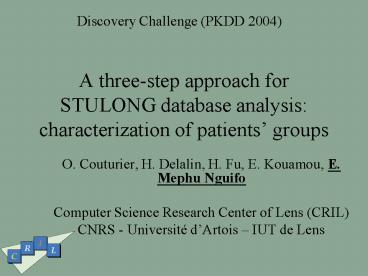A three-step approach for STULONG database analysis: characterization of patients - PowerPoint PPT Presentation
1 / 19
Title:
A three-step approach for STULONG database analysis: characterization of patients
Description:
Smoker. If smokerconsumption!=0 OR duration then 1 else 0. 13 ... AGE & SMOKER & CHOL is less frequent in group12 than in group5. etc ... – PowerPoint PPT presentation
Number of Views:57
Avg rating:3.0/5.0
Title: A three-step approach for STULONG database analysis: characterization of patients
1
A three-step approach for STULONG database
analysis characterization of patients groups
Discovery Challenge (PKDD 2004)
- O. Couturier, H. Delalin, H. Fu, E. Kouamou, E.
Mephu Nguifo - Computer Science Research Center of Lens (CRIL)
- CNRS - Université dArtois IUT de Lens
2
Goal
- What are the relations between social factors
(social characteristics) and the other
characteristics of men in the respective groups?
3
Overview
- Discovery process
- Techniques and results
- Clustering
- Classification
- Association rules
- Conclusion and further work
4
Discovery Process
- Hypothesis on data
- ENTRY table
- Groups provided by expert
- Merging groups 1 and 2 Normal group
- Merging groups 3 and 4 Risk group
- Ignoring group 6
- Characteristics
- Considering previous work of LRI ML research team
at previous PKDD Challenges
5
Discovery Process
- Can we find a model that fits with the provided
groups ? - Are there strong similarities among instances of
different groups ? - Which kind of relations exist among group
characteritics ?
6
Discovery Process
Data Tasks Knowledge
Clustering Generated clusters vs provided ones
Entry data groups Supervised classification Similarities among instances, and groups
Association rules search Affinity among groups characteristics
7
Techniques and Results Clustering
- Goal do the initials groups can be considered as
they were defined? - Data groups 12, 34 and 5
- Clustering systems (WEKA package)
- COBWEB 2 groups
- EM 4 groups
- KMEANS 2 groups
- Results difficulty to identify properties which
allow to retrieve the initial groups
8
Techniques and Results Supervised Classification
- Risk group patients similar to those in Normal or
Pathological group ? - Data
- Training set group 12 and group 5
- Test set group 34 (Risk)
- System (WEKA package)
- Decision tree C4.5
9
Techniques and Results Supervised Classification
- Training results
- HT descriptor are one of the most relevant
factors of the disease - Thirdteen instances of Pathological group are
classified as Normal
Confusion Matrix a e
lt--classified as 276 0 a 12 13 101
e 5
10
Techniques and Results Supervised Classification
- Test set Risk Group34
- Health district number is not a relevant factor
- 2/5 Risk patients similar to Normal group patients
Confusion Matrix a c d e lt--
classified as 0 0 0 0 a 12 177
0 0 250 c 3 (odd) 197 0 0 235 d
4 (even) 0 0 0 0 e 5
11
Techniques and Results Association rules search
- Goal Find relations that exist among group
characteritics - Data 1417 patients of groups 12, 34 and 5
- System
- Apriori B. Goethals implementation
- Preprocess
- Binary conversion of the 27 characteristics
- Frequent Itemsets Search
- Results
- Frequent itemsets common to different groups
12
Techniques and Results Association rules search
- Preprocessing Binary conversion
- BMI weight / size² (m)
- If bmi gt 27 then 1 else 0
- Age
- If age gt 45 then 1 else 0
- Smoker
- If smokerconsumption!0 OR duration then 1 else 0
13
Techniques and Results Association rules search
- Pre-processing Binary conversion
- Bolhr (chest pain)
- If bolhr1 or bolhr6 then 0 else 1
- Chol
- If (chol gt 2(age/100)) then 1 else 0
- Tg
- If tglt150 then 0 else 1
14
Techniques and Results Association rules search
- Frequent itemsets search
- Support threshold (Minsup) 0.10
- significant for at least 10 of the population
- Search was done with no MinSup (i.e MinSup value
0)
Itemsets Itemsets Itemsets
Class 12 Class 34 Class 5
Support value Support value Support value
15
(No Transcript)
16
Techniques and Results Association rules search
- Frequent itemsets search Results
- Support value of Alcohol attribute 1
- 1-itemsets
- Attribute IM is false for each patient of group
12 and 34. The value is true for 33 of patients
of group 5. - HT is false for each patient of group 12.
- STUDY is more frequent in group12 than in group5
- 3-itemsets
- AGE SMOKER CHOL is less frequent in group12
than in group5 - etc
- SupportValue Group 34 is between SupportValue
Group 12 and SupportValue of Group 5.
17
Conclusion
- RG similarity with NG and PG.
- 3 steps
- Clustering initial groups are not found
- Classification some attributes which
characterize the pathological group but already
known - Frequent itemsets search difficult to highlight
concrete results but interesting informations
18
Further work
- Upgrade the binary conversion
- Refining the data set on the population
- for instance, 12 patients died because of
atherosclerosis while they were in the NG. - Refining our hypothesis
- Data set of ENTRY table
- Look at the CONTROL table
19
Thanks !

